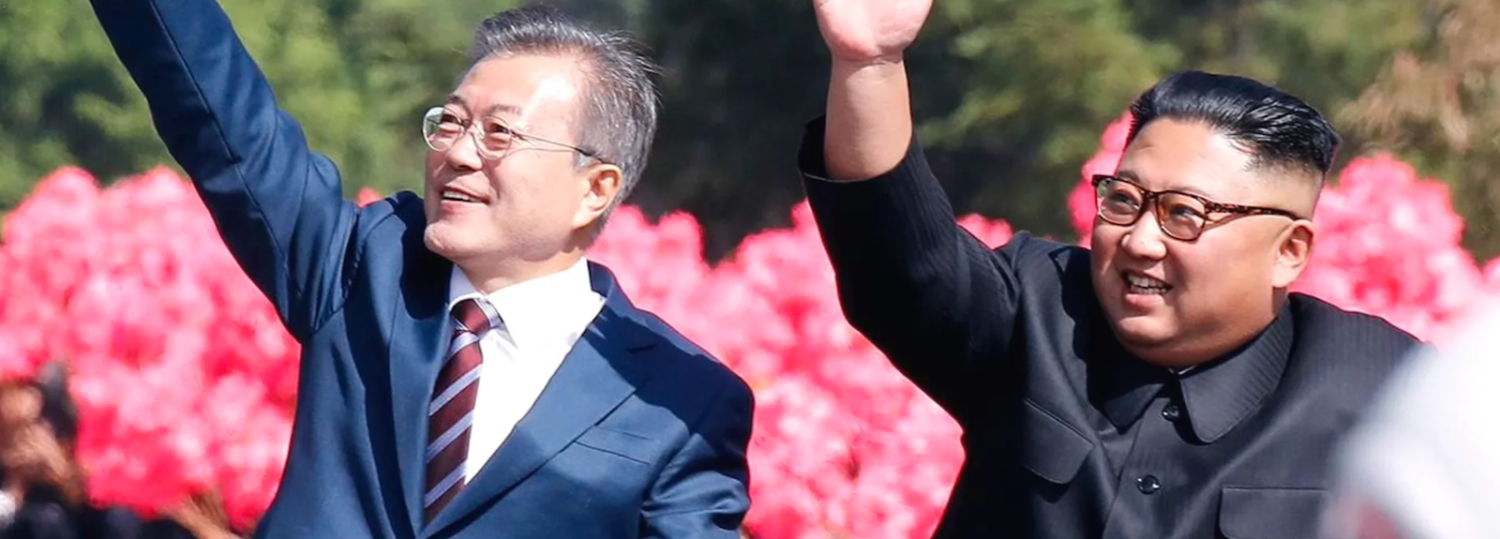Appealing to South Korea with proposals of peaceful unification, while at the same time demonising foreigners occupying the Korean Peninsula, is one of the oldest pages in Pyongyang’s rhetorical playbook.
Pyongyang is clearly painting a picture for Seoul that relations going forward could come to a choice between siding with hostile outsiders, or fellow Koreans.
It is a tactic that stretches back to the beginning of the division of the two Koreas and subsequent political struggle for legitimacy between Seoul and Pyongyang. In 1960, Kim Il-sung, North Korea’s founder and grandfather of current leader Kim Jong-un, proposed a “Koryo Federation”, in which the two Koreas united but kept their respective political systems. In a 1965 letter, Kim wrote that his proposed federation would establish a supreme national committee to coordinate economic and cultural growth while “retaining the existing political systems in North and South Korea and maintaining the independent activities of the two governments.”
Some time later, this idea of a federation resurfaced in 1973, and once more in 1980.
Now, Pyongyang is at it again.
Last month, the Korean Central News Agency (KCNA) reported on a joint conference from January 23 in which Pyongyang proposed reunification on the Korean Peninsula entailing separate political systems. This, it was said, would be on a “basis of recognising ideologies and systems existing in the north and the south and allowing them.” The background was the inter-Korean rapprochement of last year, through three summits and ongoing joint Korean projects. The report also warned against “cunning moves of outsiders to create mistrust.”
The timing of these proposals across history reveals the strategy behind them.
In all of these cases, North Korea has felt it was in a position of strength vis-a-vis the South. In the spring of 1960, South Korea was experiencing political turmoil through student uprisings and the eventual downfall of president Syngman Rhee, American imperialist puppet and enemy number one in the eyes of Pyongyang.
In 1973, the inter-Korean rapprochement of 1972 had crumbled and the two resumed their rival postures. However, the landmark Joint Communiqué of 1972, which both Pyongyang and Seoul signed, featured the Three Principles for Reunification. This ultimately favoured Pyongyang as it called for the elimination of foreign militaries on the Korean Peninsula as a condition for unification. Following this rapprochement, North and South Korea embarked on a competition for diplomatic influence across the nations of the Third World in order to control the narrative of the “Korean issue” in foreign capitals and the United Nations.
In 1980, South Korea was again experiencing a tumultuous year of domestic politics with the Gwangju Student Uprising and the government’s violent response that May.
What connection does this have with the present? After all, North Korea does not enjoy the (relative) economic and political parity it did with the South during the Cold War, and the government in Seoul is not in an existentially vulnerable state. Much has changed since Kim Il-sung took pity on the “dire plight” of the citizens of South Korea.
The statement in 2019 was not attributed to Kim Jong-un, but is likely reflective of the overall confidence Pyongyang now feels in its approach to Seoul. After spending the first part of his regime as an international pariah hell-bent on developing nuclear weapons, Kim Jong-un is now one of the world’s most sought out leaders. Following his New Year’s speech, Kim travelled to Beijing to shore up his country’s relationship with China, meeting President Xi Jinping for the third time. Next up is a second summit with the President of the United States, and after that, a possible unprecedented trip to Seoul. The leaders from Russia and Japan have also been trying to get an audience with the North Korean leader.
Not only has North Korea been engaging in diplomacy, but it has also done so without taking significant action to curtail its nuclear program.
Additionally, North Korea’s tone of reconciliation in its appeals to the South is intended to bring attention to the potentially loosening bonds of the US-South Korea relationship. US President Donald Trump has long appeared to undermine his South Korean ally in the economic, diplomatic, and military realms. The latest dispute is the cost-sharing agreement for the American military presence in South Korea.
Pyongyang is clearly painting a picture for Seoul that relations going forward could come to a choice between siding with hostile outsiders, or fellow Koreans.
In reality, the notion of reunification under two systems would most certainly be dangerous to the government in Pyongyang. With around twice the population and a GDP over 40 times larger than that of North Korea, South Korea could theoretically swallow the North if the political barriers between the two disappeared.
Nevertheless, though peninsular dynamics are much different from when Kim Il-sung proposed a federation as part of his grand scheme of uniting the Koreas under his rule, Kim Jong-un has come into his own as leader in Pyongyang. The direction of diplomacy with North Korea is still unknown, and the arguments that Kim Jong-un may break the cycle and reform the country may turn out to be true. Yet the latest message from Pyongyang highlights the constant struggle for leverage in inter-Korean relations.
In this respect for Kim Jong-un, the apple doesn’t fall too far from the Great Leader tree.

